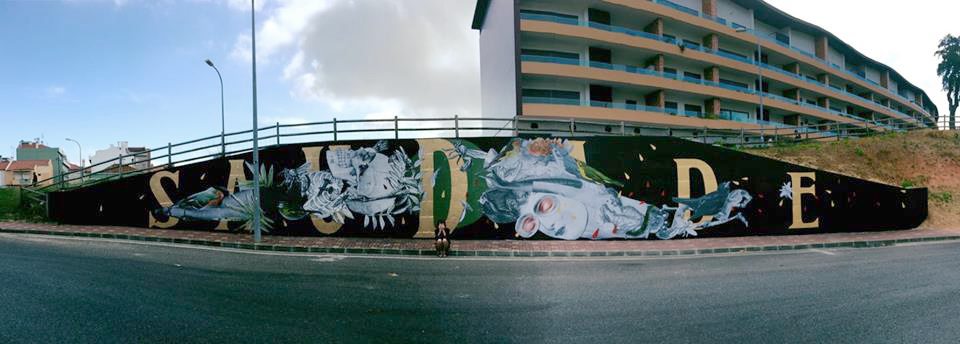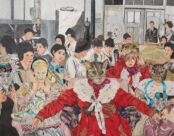[dropcap style=”font-size:100px;color:#992211;]A[/dropcap]s often as not, the stage sets for Matthew Bourne’s contemporary ballets put the spectator in mind of large scale works by Joseph Cornell. (Cornell’s small-scale boxes and collages are little dreams of Paris hotels, exotic birds, bottles, beads and ballerinas.) At the scale of stage sets,but with the delicacy of Cornell’s assmblages, Paris is home to some beautiful street art.
It was a delight, therefore, to happen upon the work of street artist, Madame Moustache.
Madame is a Parisian who works between scales, often making Cornell type boxes and collages and then working them up to architectural scale and placing them on walls.
On her website, she photographs these with her face covered or the face of one of her co-workers covered, either out of modesty or out of a desire not to be recognized.
Her latest work is situated on the Paris canal near Stalingrad, to the north-east at Bassin de la Villette. The work was one of several commissioned for the Festiwall #3, an annual festival of contemporary street art.
It is by far the most beautiful piece in the festival.
Here is Madame Moustache in one of her previous pieces sitting on the first-floor window-ledge.
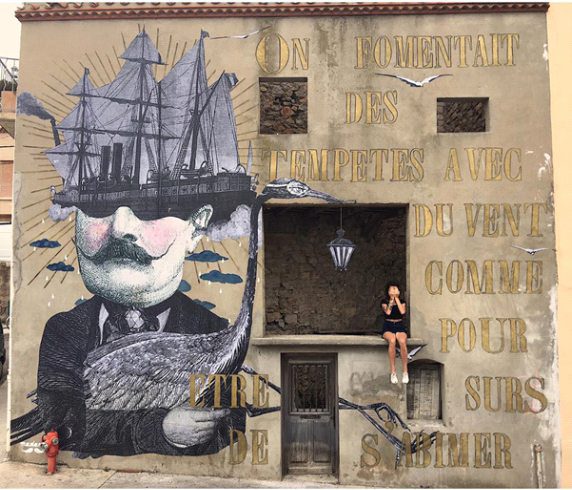
Madame Moustache, Fomenter des tempêtes avec du vent…, 2017
The text reads, ‘ON FOMENTAIT DES TEMPETES AVEC DU VENT COMME POUR ETRE SURS DE S’ABIMER,’ translating as, ‘Storms were fomented with wind as if to be sure to get lost.’ Such are the enigmatic poems Madame inserts into her pictures.
The piece at the Bassin is a melancholic depiction of two nuns, whose heads come together each side of a high barred window. The fugitive gold lettering spells, ‘POUR VIVRE PEUREUX VIVRONS CLOITRÉS,’ which translates into English as, ‘To live fearfully, live cloistered.’
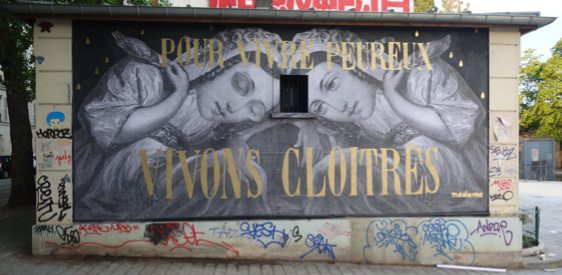
Madame Moustache, POUR VIVRE PEUREUX VIVONS CLOITRÉS, 2018
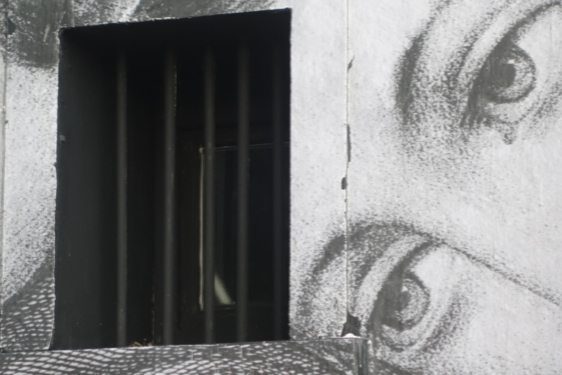
(detail)
The cryptic crossworder and the pub punster will have noticed the resemblance between the French word, ‘cloitrés’ and the word in both French and English (from the Latin) ‘Clitoris’. Is this part of Madame’s suggestion?
Simone de Beauvoir, we had to wait until 2009 for a full English translation of her, Second Sex, remarks,
The female is a woman, insofar as she feels herself as such. Some essential biological givens are not part of her lived situation: for example, the structure of the ovum is not reflected in it; by contrast, an organ of slight biological importance like the clitoris plays a primary role in it. Nature does not define woman: it is she who defines herself by reclaiming nature for herself in her affectivity. (Beauvoir, 2009) (p. 73)
Are these two wives of Christ in fear and living cloistered? It appears not. For they are on the outside of what is to be interpreted as a cell.
They are out; and thanks to women like Beauvoir, they have no need to live fearfully.
Beauvoir again,
Between women there is a complicity that disarms modesty; the excitement one arouses in the other is generally without violence; homosexual embraces involve neither defloration nor penetration: they satisfy infantile clitoral eroticism without demanding new and disquieting metamorphoses. The girl can realize her vocation as passive object without feeling deeply alienated. (Beauvoir, 2009) ( p. 413)
In another piece, ‘YOU KNOW WHAT? I DON’T UNDERSTAND MEN,’ our artist sets her self an existential puzzle; and how many men have felt bewildered confronted with ‘woman’?
Beauvoir, in her short essay for Les Temps Moderne, ‘Women and Myth,’ opens with the sentence, ‘He is The Absolute, and She is The Other.’ That theme is developed in her magnum opus where she writes of men conceiving of women as incomplete and thus not well suited to making choices.
In countering this she calls upon each person to find their freedom; and argues that this freedom cannot be subjugated to a naturalisation of what we are as men and women.
However, in a stark passage she argues that women’s self-awareness and freedom is often at odds with the interests of the species. That is, the naturalism that claims her for the reproduction of the species ought to be resisted by her if she so chooses.

Woman’s eroticism is far more complex and reflects the complexity of her situation. It has been seen that instead of integrating forces of the species into her individual life, the female is prey to the species, whose interests diverge from her own ends; this antinomy reaches its height in woman; one of its manifestations is the opposition of two organs: the clitoris and the vagina. At the infant stage, the former is the center of feminine eroticism (…) The clitoral system does not change with adulthood, and woman preserves this erotic autonomy her whole life; like the male orgasm, the clitoral spasm is a kind of detumescence that occurs quasi-mechanically; but it is only indirectly linked to normal coitus, it plays no role whatsoever in procreation. The woman is penetrated and impregnated through the vagina; it becomes an erotic center uniquely through the intervention of the male, and this always constitutes a kind of rape. (Beauvoir, 2009) ( p. 442)
Reading Beauvoir might give men an insight into the question, ‘What is woman?’ but Madame Moustache’s attempts to understand men might fail because men hardly understand themselves.
We do not know what we are. That is what is so absurd about human beings.
Better, then, to lose oneself in poetry and art, where a lack of literal understanding permits something like a glimpse of meaning – a sort of emblematic shadow.
Immanuel Kant’s aesthetic ideas are illustrated in poetry, where rational ideas, such as love, or death, or providence, cannot be literally represented and only by use of allegory, metaphor and figuration, can we feel our way toward a ‘picture’ of what we are or might be.
That kind of figuration is at work in Madame Moustache’s street art. The smaller scale works from which she builds the larger pieces are themselves delightful small objects that have something of the reliquary about them.
They have that mysterious quality that poetry has, of making you feel that you have grasped something, but you aren’t quite sure what. Here are a couple of the smaller pieces from her website.
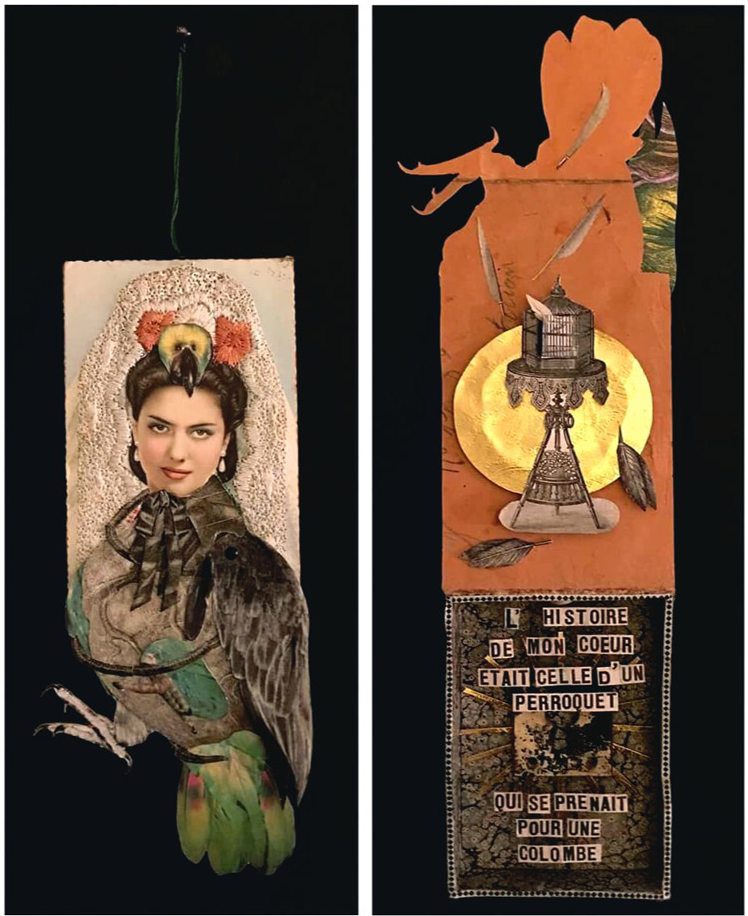
Madame Moustache, La Colombe, 2016
The Colombian beauty with the body of an exotic bird (half ballerina, half guan) is very much in sympathy with Cornell. It has that same charm and fit. It is oddly believable that such a hybrid creature of such beauty exists.
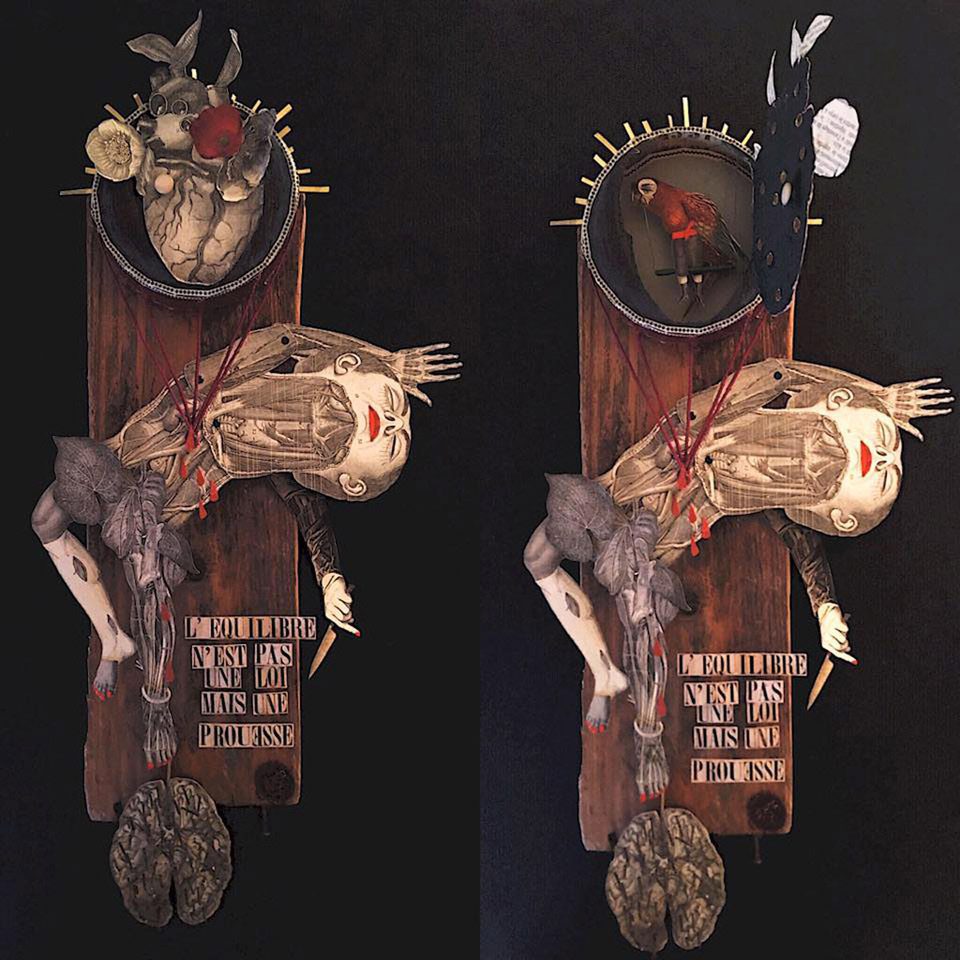
Madame Moustache, Le Pesanteur, 2017 (left, round box closed; right, round box open)
In Le Pesanteur, the round box at the top of the assemblage is a heart, that when opened presents a small red bird. L’EQUILIBRE N’EST PAS UNE LOI MAIS UNE PROUESSE, translates as ‘Balance is not a law but a feat.’ A female puppet dangles from a circular box (a hot-air balloon?) upon which is glued a heart.
When opened the box contains a small red bird. A caged bird dreams of freedom. The puppet is composed of anatomical drawings that lay bare the mechanisms of life. The heart is a pump – a piece of machinery, the bird is not. It lives.
The work, both in the studio and in the street, is intoxicating.
References: Simone de Beauvoir, Le deuxième sexe copyright © 1949 by Éditions Gallimard, Paris
Translation copyright © 2009 by Constance Borde and Sheila Malovany-Chevallier
Introduction copyright © 2010 by Judith Thurman. Page references are to the 2011 edition, New York: Vintage Books
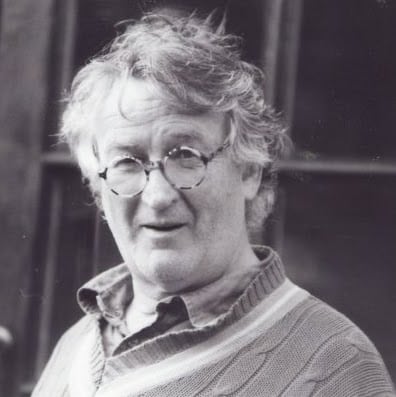
Ed studied painting at the Slade School of Fine Art and later wrote his PhD in Philosophy at UCL. He has written extensively on the visual arts and is presently writing a book on everyday aesthetics. He is an elected member of the International Association of Art Critics (AICA). He taught at University of Westminster and at University of Kent and he continues to make art.

